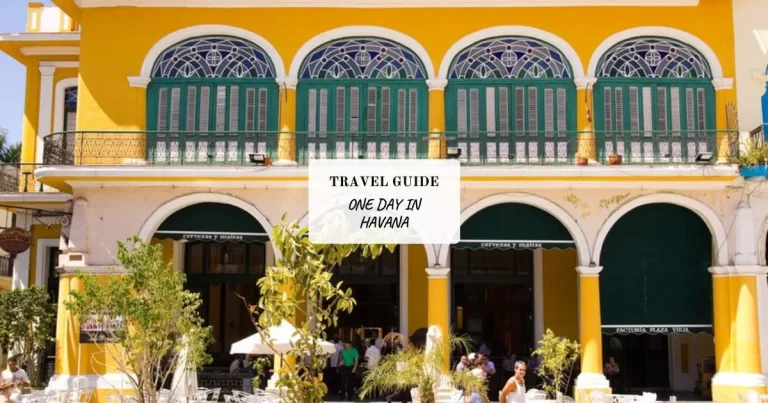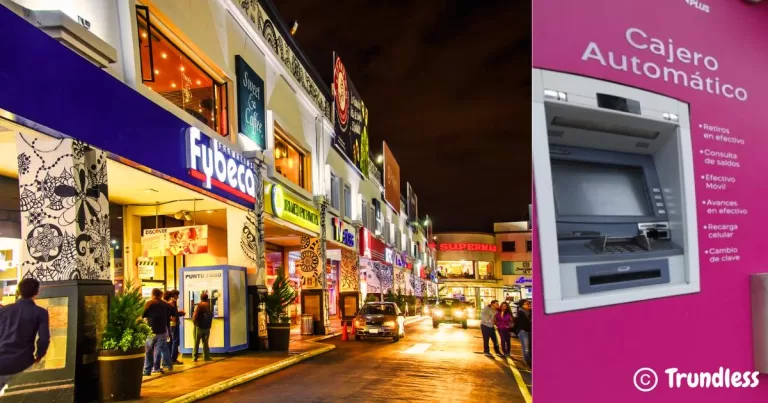Ecuadorian Food: 11 Traditional Dishes You Must Try in Ecuador
Ecuadorian cuisine is a vibrant collection of flavors influenced by the country’s rich cultural heritage and diverse geography. From the lush Amazon rainforest to the towering Andean peaks and the bustling coastal regions, each area contributes unique flavors and ingredients to the national palate. Exploring local food is an essential part of understanding Ecuador’s culture and traditions.
Tourists from all over the world flock to Ecuador for its famed food tours, showcasing the country’s culinary diversity. Each delicacy offers a distinct taste and representation of the region where it came from, making every bite a journey through Ecuador’s varied landscapes.
Why You Shouldn’t Miss Ecuadorian Cuisine
- Diverse Range of Options: Ecuador offers a wide range of culinary delights, from hearty mountain dishes to fresh seafood along the coast.
- Cultural Insight: Trying local foods is a gateway to understanding the country’s rich traditions and heritage.
- Unique Regional Flavors: Each region boasts its own specialties, ensuring that you experience a broad spectrum of tastes.
If you are visiting Ecuador, make sure to not miss the scrumptious food and gastronomy they offer. It’s not just about eating; it’s about savoring the essence of Ecuador in every dish.
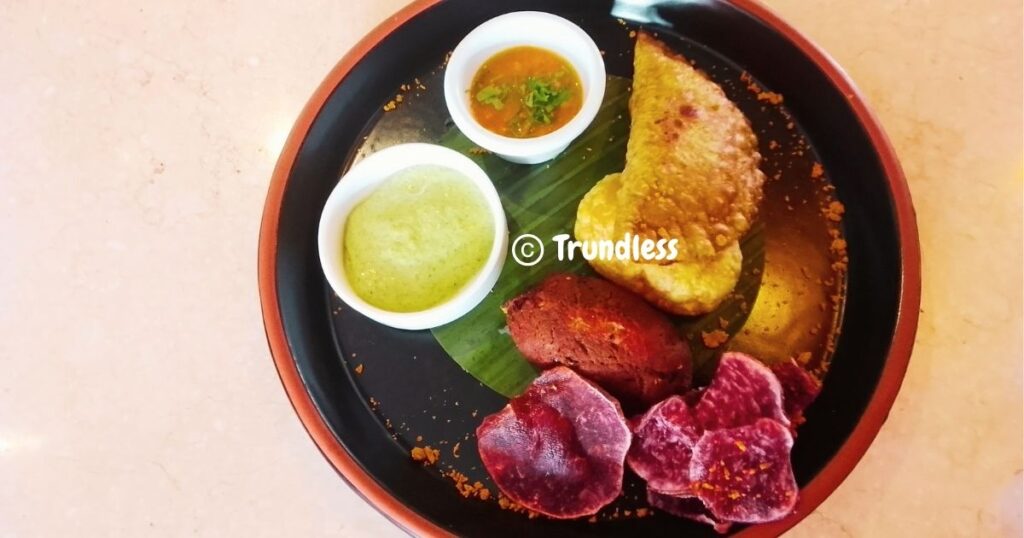
In this article, you will discover the top 11 foods to try in Ecuador, each with a brief description that highlights its significance and unique taste. Get ready for a culinary journey that promises to delight your senses and enrich your travel experience.
For those planning their first trip to Ecuador, it’s vital to be well-prepared. We offer an ultimate guide for first-time travelers, filled with essential tips on planning, budgeting, safety, and embracing new cultures for a memorable adventure. You can find these helpful tips here.
Additionally, our blog is a treasure trove of expert travel tips, city guides, and essential advice that can help you navigate your journey with confidence. Explore our blog here for more insights.
The Influence of Geography on Ecuadorian Food
Ecuador’s culinary traditions are deeply influenced by its diverse geography, which spans coastal areas, highlands, and the Amazon rainforest. Each region contributes unique flavors and ingredients to the national cuisine, making Ecuador a destination rich in gastronomic variety.
Coastal Cuisine
The coastal regions of Ecuador are known for their abundant seafood, reflecting the proximity to the Pacific Ocean. Dishes like ceviche—a refreshing preparation of fresh fish marinated in citrus juices—are staples here. The use of coconut in dishes such as encocado de pescado (coconut fish stew) highlights the tropical influence. Coastal cuisine often incorporates plantains, either fried or boiled, adding a distinctive texture and flavor.
Andean Flavors
In the highlands, or Andes region, the cuisine is characterized by hearty and comforting foods designed to fuel people living in mountainous terrains. Staples like potatoes and corn dominate this region’s culinary landscape. Llapingachos, cheesy potato patties, and locro de papa, a creamy potato soup, are prime examples of Andean flavors. Pork also plays a significant role here, with dishes like fritada—crispy pork served with hominy and fried plantains—being particularly popular.
Amazonian Ingredients
Amazonian cuisine introduces exotic elements not found elsewhere in the country. The lush rainforest provides an abundance of unique ingredients like yuca (cassava), various tropical fruits, and freshwater fish. Traditional dishes from this region often feature these components, offering a taste that’s both adventurous and rooted in indigenous practices.
Exploring Ecuador’s diverse culinary landscape offers you a deeper understanding of its culture and traditions. To make your travel experience seamless, consider checking out our travel essentials guide, which covers must-have items for a stress-free trip.
For more insights into exploring this South American gem and its stunning landscapes, vibrant culture, and unforgettable adventures, visit our dedicated section on Ecuador.
1. Ceviche: A Taste of the Coast
Ceviche stands out as one of Ecuador’s most iconic dishes. This seafood dish is made with fresh fish marinated in citrus juices, typically lemon or lime, which “cooks” the fish in acidity. The result is a refreshing and tangy flavor that’s perfect for hot coastal days.
Regional Variations
- Coastal Ceviche: More popular along the coast, this version often includes shrimp, octopus, and other shellfish.
- Highland Ceviche: Less common but equally delicious, usually featuring trout or tilapia adapted to high-altitude preferences.
Vegan Variation: Cevichocho Vegano
What is Cevichocho Vegano, and What Are Its Main Ingredients? Cevichocho Vegano is a vibrant and refreshing vegetarian ceviche dish that highlights the unique flavor of lupini beans, also known as chocho beans. This plant-based ceviche is a staple in Ecuadorian cuisine, offering a delicious and healthy alternative to traditional seafood ceviche.
Pairing Suggestions
For an authentic experience, pair your ceviche with popcorn or plantain chips. The crunchy texture complements the tender marinated fish perfectly.
Pro Tip: Interested in exploring Ecuador safely? Check out these travel tips for a secure journey.
For more comprehensive travel safety advice, visit this page on essential safety tips for travelers.
2. Llapingachos: Cheesy Potato Patties from the Highlands
Llapingachos are a beloved traditional Andean street food, known for their irresistible combination of mashed potatoes and cheese. These savory potato patties are typically prepared by mashing boiled potatoes and mixing them with cheese, then forming the mixture into small patties that are fried until golden brown.
Common serving suggestions for llapingachos include:
- Avocado slices: Adding a creamy texture.
- Peanut sauce: Enhancing the dish with a rich, nutty flavor.
These accompaniments complement the cheesy and slightly crispy texture of the patties, making llapingachos a must-try when exploring Ecuadorian cuisine.
To truly immerse yourself in the culinary delights of Ecuador, it’s worth exploring beyond just the food. The country is home to stunning biodiversity, unique wildlife, and breathtaking landscapes. For an in-depth exploration of these wonders, refer to our comprehensive guide to Ecuador and the Galápagos Islands.
3. Bolon de Verde: Green Plantain Balls with a Twist
Bolon de verde is a beloved snack throughout Ecuador, capturing the essence of traditional flavors and textures. These delightful treats are made from mashed green plantains, which are then shaped into balls and filled with savory pork or cheese.
Why Bolon de Verde Stands Out
- Ingredients: The primary ingredient, green plantains, provides a starchy base that becomes a perfect vehicle for the fillings.
- Texture: When fried, bolon de verde achieves a crispy exterior while maintaining a soft, tender interior.
For an authentic experience, enjoy these plantain balls with a side of hot sauce or ají to add an extra kick. Whether you’re wandering through coastal villages or bustling highland markets, bolon de verde offers a satisfying bite that embodies Ecuadorian culinary tradition.
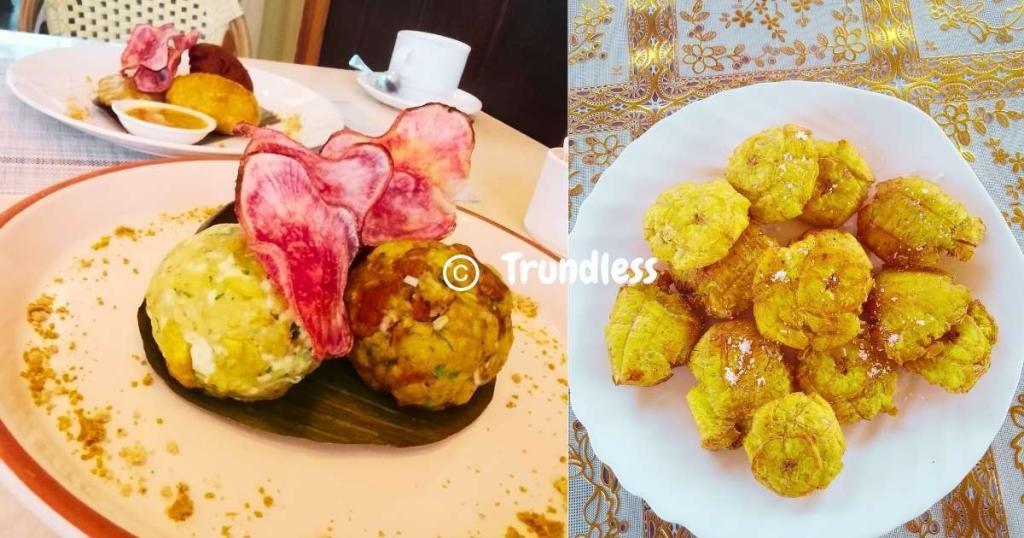
4. Encocado de Pescado: Coconut Fish Stew from the Coast
Encocado de pescado is a flavorful stew that embodies the essence of Ecuador’s coastal cuisine. This dish features tender fish cooked in a rich, creamy coconut sauce infused with spices, creating a harmonious blend of flavors that dance on your palate.
Key Details
- Ingredients: Fresh fish, coconut milk, onions, bell peppers, cilantro, and spices.
- Cooking Method: The fish is simmered gently in the coconut sauce until it absorbs the aromatic flavors.
- Serving Suggestions: Often served with rice or patacones (fried green plantains) to balance the rich stew.
The use of coconut is pivotal in coastal Ecuadorian dishes. It adds a unique sweetness and creaminess that sets this dish apart from other fish stews. Encocado de pescado is a must-try for anyone looking to experience the depth and variety of Ecuadorian coastal cuisine.
5. Encebollado: The Ultimate Hangover Cure Soup
Encebollado, often hailed as Ecuador’s national dish, is a hearty fish soup that combines the robust flavors of fresh fish, yuca (cassava), and pickled onions. This comforting soup is not only popular for its taste but also revered for its restorative properties.
Key Ingredients:
- Fish: Typically tuna or albacore.
- Yuca (Cassava): Adds a starchy, satisfying texture.
- Pickled Onions: Infuses a tangy and slightly sweet flavor.
Ecuadorians often turn to encebollado as a remedy for hangovers due to its rich broth and revitalizing ingredients. The combination of protein from the fish and the carbohydrate-rich yuca makes it an ideal choice to recover after a night out.
Serving Suggestions:
- Lime: A squeeze enhances the flavor profile.
- Chifles (Fried Plantain Chips): Often served on the side for added crunch.
This beloved dish offers an authentic taste of Ecuadorian cuisine while showcasing the country’s ability to blend simple ingredients into something extraordinary.
6. Cuy Asado: A Unique Delicacy from the Highlands
Cuy asado or roasted guinea pig is a traditional highland dish that may surprise some travelers but is highly regarded by locals. This unique delicacy has been a staple in Andean cuisine for centuries and holds cultural significance in many highland communities. Although guinea pigs are frequently kept as pets in North America, they are considered livestock in the Andes, where they have always been raised for their meat, often compared to rabbits.
Preparation Methods
Preparation methods for cuy asado typically involve:
- Cleaning and seasoning the guinea pig with a blend of spices
- Roasting it over an open flame or in a traditional clay oven (known as a pachamanca)
- Achieving a crispy, golden-brown skin while maintaining tender, flavorful meat
Cuy can also be prepared grilled or fried, showcasing its versatility in Ecuadorian cuisine.
Flavor Profile
The flavor profile of cuy asado is often described as rich and slightly gamey, akin to a combination of rabbit and poultry. It’s commonly served with side dishes such as boiled potatoes, corn on the cob, and various dipping sauces to enhance the overall taste experience.
Cultural Importance
Roasted guinea pig plays a significant role in Ecuadorian cuisine and culture. For those looking to immerse themselves fully in Ecuadorian culture, trying cuy asado offers an authentic and memorable culinary adventure. Like any cultural cuisine, sampling it provides a deeper understanding of the local traditions and lifestyle.
Where to Try Cuy Asado
The most popular places and markets to try cuy in Ecuador are located in Cuenca. This city offers numerous spots where you can experience this traditional dish, making it an ideal destination for culinary explorers eager to embrace Ecuadorian flavors.
7. Locro de Papa: Creamy Potato Soup to Warm Your Soul
Locro de papa, a beloved Andean specialty, is the epitome of Ecuadorian comfort food. This creamy potato soup features potatoes cooked down into a velvety consistency, often enriched with cheese and avocado slices.
- Ingredients: Potatoes, cheese, avocado
- Common Additions: Corn, chorizo
Ideal during colder months, locro de papa provides warmth and satisfaction in every spoonful. Each region adds its own twist, but the essence remains—a comforting bowl that feels like home. This dish serves as a perfect introduction to the heartwarming cuisine of Ecuador’s highlands.
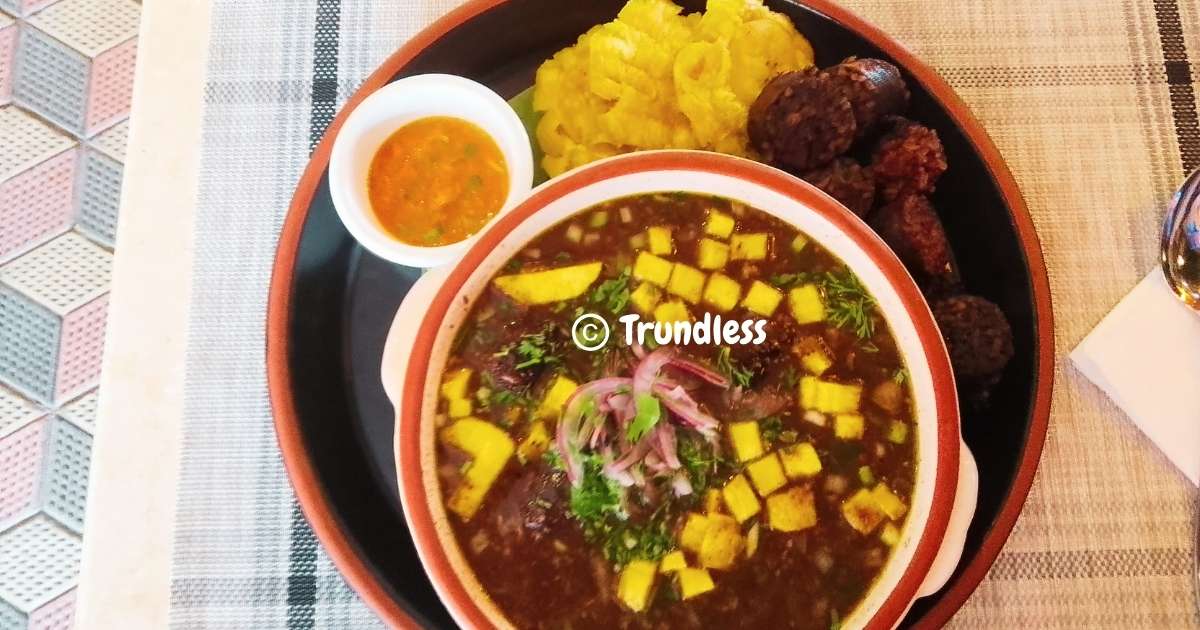
8. Fritada: Crispy Pork Delight from the Andes
Fritada, a beloved highland dish, showcases Ecuadorian cuisine’s knack for transforming simple ingredients into culinary delights. This crispy pork dish starts with chunks of pork boiled until tender, absorbing subtle flavors from spices and herbs. The magic happens when the boiled meat is fried to achieve a golden, crispy exterior, creating a delectable contrast between the juicy interior and crunchy outside.
Common accompaniments enhance the fritada experience:
- Hominy (dried corn): Adds a chewy texture and mild flavor that complements the pork.
- Fried plantains: Offer a sweet and savory balance, elevating each bite.
Together, these elements create a harmonious blend of textures and flavors, making fritada a must-try for any culinary explorer in Ecuador.
9. Humita: Sweet Corn Treat Wrapped in Tradition
Humita is a traditional Andean snack that is loved for its delicious flavors and unique way of making it. It is made from steamed corn dough and includes ground corn mixed with cheese or sweeteners like sugar or cinnamon powder, making it a versatile treat that can be either savory or sweet.
One thing that makes humitas special is how they are wrapped. The mixture is carefully wrapped in banana leaves, which not only adds a subtle earthy flavor but also helps keep the moisture in while steaming. This technique results in a soft and tasty snack that is enjoyed all over Ecuador.
Humitas are an ancient delicacy that transcends the Hispanic period. In Ecuador, they are typically made with freshly ground maize, onions, garlic, cheese, eggs, and heavy cream. This gives them a rich and creamy texture that sets them apart from other similar dishes.
- Ingredients: Freshly ground maize, onions, garlic, cheese, eggs, heavy cream, or sweeteners (sugar, cinnamon powder)
- Wrapping: Banana leaves or corn husk
- Cooking Method: Steamed or boiled
While humitas are similar to tamales, a key difference is that humitas are made using fresh maize rather than masa, which gives them a distinct texture and flavor. They are particularly well-known in Ecuador’s Highlands, where they are typically consumed for breakfast or as a mid-day snack with coffee.
You can find humitas at local markets and street vendors, making them an easy-to-find and must-try delicacy when exploring the diverse food scene of Ecuador.
10. Seco de Chivo: Flavorful Goat Stew from the Highlands
Seco de chivo, or goat meat stew, is a quintessential dish from Ecuador’s highlands. This hearty stew is slow-cooked to perfection, allowing the flavors of spices like cumin and coriander to develop deeply over time. The result is a rich and aromatic dish that warms your soul with every bite.
- Ingredients: Goat meat, cumin, coriander, onions, garlic, tomatoes
- Preparation: Slow-cooked for tender meat and deep flavor
Seco de chivo pairs beautifully with rice or potatoes, making it a versatile meal that complements any side dish. The combination of the tender goat meat and the flavorful sauce creates an unforgettable culinary experience.
For an authentic touch, don’t forget to add a few slices of ripe avocado on the side. This traditional recipe offers a perfect introduction to the rich culinary traditions of Ecuador’s highlands.
Other Food from the Ecuador Highlands: Hornado
What is Hornado, and How is it Typically Prepared and Served? Hornado is a traditional Ecuadorian dish, particularly famous in the highlands. It features a whole pig that is slow-roasted to perfection over hot coals. The preparation process begins by marinating the pig in a flavorful mixture of ingredients including onions, garlic, cumin, fermented corn drink (chicha), and annatto, which imparts a distinct color and taste.
11. Empanadas de Viento: Deliciously Crispy Pastries Filled with Cheese
Empanadas de viento are a beloved street food in Ecuador, celebrated for their flaky dough and savory fillings. These deep-fried snacks are typically stuffed with cheese, creating a deliciously gooey interior encased in a crispy, golden-brown exterior. The name “empanadas de viento,” which translates to “wind empanadas,” aptly describes their light and airy texture.
While cheese is the most popular filling, other variations exist to suit different tastes:
- Meat: Ground beef or chicken seasoned with spices.
- Vegetables: A mix of sautéed veggies for a lighter option.
- Sweet fillings: Some versions even include fruit preserves for a sweet twist.
These versatile pastries are perfect for any time of day, whether as a quick snack or a hearty meal component. Enjoy them hot from the fryer for the best experience.
Other Similar Crisply Pastries
Corviche is a delicious Ecuadorian dish that combines green plantains and fish, typically albacore or tuna. The plantains are mashed and seasoned, then wrapped around the fish filling, sometimes with peanut butter for added flavor. These bundles are fried to achieve a crispy exterior and moist interior. Popular as street food or an appetizer, Corviche highlights the rich culinary traditions of Ecuador.
A Traditional Ecuadorian Drink to Try
What is Colada Morada, and When is it Traditionally Served in Ecuador?
Colada Morada is a vibrant, purple beverage that is popular in Ecuador. This flavorful drink is a concoction made from blackberries, blueberries, raspberries, and a variety of regional spices. Rich and slightly thick, it’s often described as a fruity, spiced delight.
Traditionally, Colada Morada is served during the Day of the Dead celebrations, known locally as Día de los Difuntos. This holiday, observed on November 2nd, is a time when families honor and remember their deceased loved ones. In Quito’s historic old town and throughout Ecuador, enjoying Colada Morada is a cherished part of this cultural observance.
So, if you find yourself in Ecuador during early November, participating in this tradition offers both a taste of local flavors and a deeper appreciation of the country’s customs.
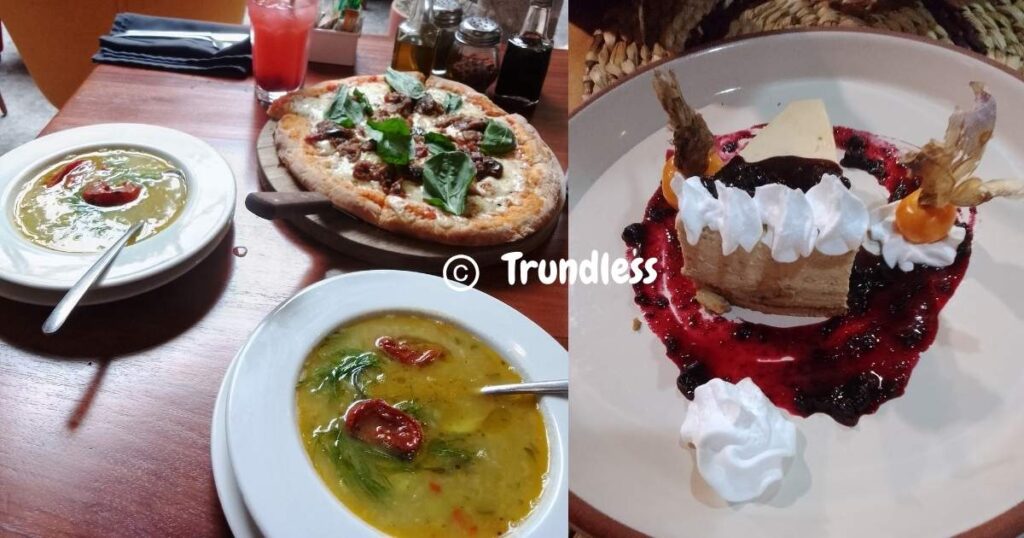
Other Ecuador Food You Can Try?
- Guatita is a cherished stew known for its delightful mix of tripe, potatoes, and a savory peanut sauce. The tripe, often the star of the dish, is carefully cooked and finely chopped to ensure it blends harmoniously with the creamy, nutty potato sauce, creating a well-balanced and enjoyable meal.
- Fanesca is a traditional soup, deeply rooted in the country’s Easter and Lent celebrations. This unique dish boasts a rich and hearty blend of ingredients. The soup’s base is made from bacalao, a type of dried and salted fish, which is boiled in milk. What makes Fanesca truly special is its array of complementary ingredients. You’ll find sambo (figleaf gourd), zapallo (pumpkin), and mellocos (Andean potatoes) in this dish. Additionally, it features twelve different types of beans and grains, symbolizing the twelve apostles in Christian tradition.
- Tigrillo is a traditional dish, particularly beloved in the coastal regions of the country. This breakfast delight brings together savory and rich flavors that make it a staple in many households.
- Churrasco Ecuatoriano is a beloved staple. This dish features thin cuts of steak, which are either grilled to perfection or occasionally pan-fried alongside onions and peppers. A distinct characteristic of Churrasco Ecuatoriano is the crowning touch—a crispy fried egg placed atop the steak.
- Arroz con camarones translates to “rice with shrimp” and features succulent shrimp mixed with aromatic yellow rice. Traditionally prepared in a homemade shrimp stock, this dish boasts a deep seafood flavor.
- Mote con Chicharrón is a popular dish that showcases a delightful combination of two main ingredients. The first is mote, which consists of large, puffy kernels of corn that have been dried, rehydrated, and cooked to perfection. The second key ingredient is chicharrón, featuring crispy, savory pieces of pork belly that are perfectly fried to a golden brown. Together, these elements create a flavorful and satisfying dish.
- Patacones, also known as tostones, are a popular Latin American treat made from green plantains. They are sliced, fried until golden, flattened, and then fried again for extra crispiness. Often enjoyed as a snack or side dish, patacones are typically served with a variety of dipping sauces or toppings like cheese and garlic.
- Espumilla is a dessert that brings together the flavors of tropical fruits and the airy texture of meringue. This delicious treat is typically made using guava pulp, egg whites, and sugar, resulting in a sweet and fluffy concoction often compared to ice cream because of its presentation.
- Crema de Maiz, also known as cornmeal cereal or creamy corn soup, is a comforting traditional dish enjoyed throughout South America. Popular in places like Ecuador, this versatile soup provides warmth and satisfaction.
Where to Experience These Culinary Delights in Ecuador?
Exploring Ecuador’s diverse culinary landscape means visiting a variety of locales. Below are some recommended spots where you can savor authentic versions of the top dishes across different regions:
Quito
- La Ronda: This historic street offers a multitude of eateries where you can try empanadas de viento and fritada. It’s a vibrant place for experiencing traditional highland cuisine.
- Mercado Central: Known for its wide selection of dishes, this market is ideal for tasting locro de papa and llapingachos. The bustling environment adds to the authenticity.
Guayaquil
- Malecon 2000: Along the riverfront, you’ll find various restaurants specializing in coastal dishes like ceviche and encocado de pescado. It’s a scenic spot to enjoy these delights.
- Mercado Caraguay: Famous for its seafood, this market is perfect for trying encebollado, often hailed as the best hangover cure in Ecuador.
Cuenca
- San Francisco Market: This local market offers a range of Andean specialties such as humita and seco de chivo. The atmosphere is both inviting and authentic.
Coastal Towns (Manta, Esmeraldas)
- Playa Murciélago in Manta: Popular among locals and tourists alike, beachside stalls here offer fresh ceviche paired with plantain chips or popcorn.
- Esmeraldas Local Markets: In this Afro-Ecuadorian heartland, you can find rich coconut-infused dishes like encocado de pescado, reflecting the region’s unique culinary heritage.
Sampling these foods at their places of origin adds an extra layer of cultural richness to your travel experience. Each region offers distinct flavors that make Ecuador a culinary paradise worth exploring.
Tips for Enjoying Ecuador’s Food Like a Local!
Be Adventurous
Embrace the spirit of discovery when sampling Ecuador’s food. From exotic fruits in the Amazon to seafood specialties on the coast, each bite is an opportunity to explore new flavors.
Ask Locals for Recommendations
Locals know best. Engage with them to uncover hidden gems and off-the-beaten-path eateries. Authentic tastes often lie in places only residents frequent.
Mind Dietary Restrictions
Some Ecuadorian dishes might be spicy or contain allergens like seafood or nuts. Always inquire about ingredients if you have dietary restrictions or preferences.
Join Food Tours and Cooking Classes
Food Tours: These provide curated experiences that highlight the best of Ecuadorian cuisine.
Cooking Classes: Learn how to prepare traditional dishes, offering a deeper understanding of the cultural significance behind each recipe.
Ecuadorian food experiences are rich and diverse, making every meal a part of your culinary journey in Ecuador.


